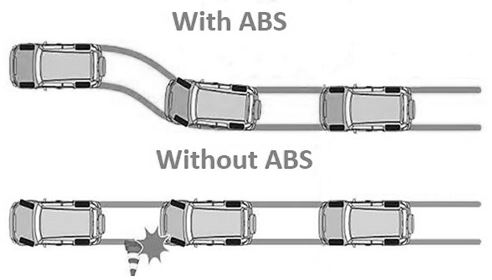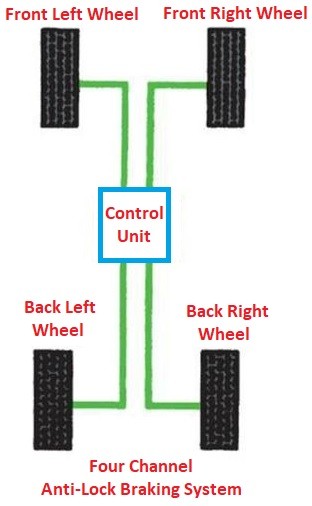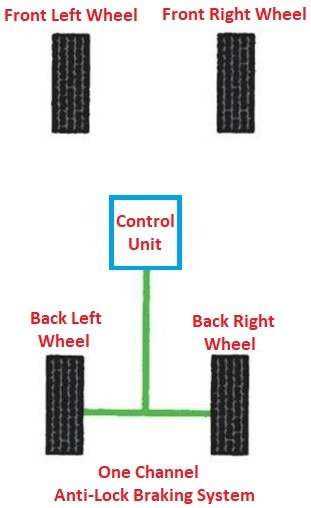What is Anti-Lock Braking System?
Anti-Lock Braking System, generally referred as Anti-Skid Braking System, one of the types of braking system, which are automated systems. Anti-Lock Brakes are used in vehicles like Cars, Motorcycles, Trucks, Buses and as well as in Aircraft to prevent the wheels from locking up during braking. Anti-lock braking systems work with the vehicle’s regular brake system and allow drivers to maintain more control over the vehicle by automatically pumping the brakes in the event of a sudden stop.

Anti-Lock braking is based on the principles of Threshold Braking and Cadence Braking. Threshold Braking and Cadence Braking help us to avoid the skidding and ceasing of wheels rotation in the situations where we suddenly apply the pressure on the brake pedal to avoid a collision.
In simple words, the Locking reduces the adhesion between tires of vehicles and the surface that makes the vehicle unstable and it moves in the skid direction irrespective of steer direction. As a result of this, our wheels can lose traction. Moreover, it can also cause the driver to lose the ability to steer and a fatal accident can also take place, to avoid such situations; we use Anti-Lock Braking System (simply ABS) in our vehicles to prevent them from locking and skidding.
Also Read:
- Hydraulic Brake System – Parts, Types, Working, Advantages, Disadvantages, and Applications – FAQ’s
- Vacuum Braking System – Parts, Working, Advantages, Disadvantages, And Applications – FAQ’s
The first Anti-Lock Braking System was developed by French pioneer Gabriel Voisin in the 1920’s but Anti-Lock Braking System was adapted and introduced in the commercial vehicle market on a large scale in the 1970’s. The good thing about the Anti-Lock Braking System is that it prevents the wheels from locking-up and it also ensures that we still have some control over the vehicle and the wheels continue to rotate and our vehicle moves further.
Types of Anti-Lock Braking System
Anti-lock braking system are of different types based on number of speed sensors and valves. To simplify, we can divide them into 3 main types.
- Four Channel Four Sensor ABS
- Three Channel Three Sensor ABS
- One Channel One Sensor ABS
Four Channel Four Sensor ABS

In this type of Anti-Lock braking system, we have separate speed sensors and separate valves for all four wheels. The main monitor controls each wheel and ensures that it achieve maximum brake force when brakes are applied.
Three Channel Three Sensor ABS

This is another type of Anti-Lock braking system, which is used in pickup trucks (four wheels) and other vehicles because this setup provides control of the front wheels individually; this setup consist of a speed sensor and a valve for each front wheels but only one valve and one sensor for rear wheels, which is located in the rear axle, and the system can achieves maximum braking force by using a valve and a sensor each one separately for front wheels.
One Channel One Sensor ABS

This type of Anti-Lock braking system is also commonly used in pickup trucks in which we have rear-wheel ABS, which means it has only one valve. The main purpose of using this setup is to control both rear wheels, with one speed sensor located in the rear axle. This setup monitors the rear wheels together.
Parts of Anti-Lock Braking System
As we know, this is sensor based braking system so, an Anti-Lock Braking System consists of mainly
- ABS Speed Sensors
- Valves
- Pump
- Brake Fluid
- Controller/Control Unit (ECU-Electronic Control Unit)
We can clearly get to know about these parts in the working of Anti-Lock Brakes.
Working of Anti-Lock Braking system
For better understanding of working principle of anti-locking braking system. First of all, we have to understand what happens when we brake hard on a vehicle without an ABS system in low grip conditions (on snowy or wet roads).
- The traction between the road and wheels is very low.
- As we know pedal will apply braking action on the wheels but due to less traction (grip) of tyres in contact with the road surface, the wheels of our vehicle will stop rotating and the car will be in motion.
We already know that ABS works on the principle of threshold braking. If in case there is an obstacle ahead of the vehicle in low grip conditions, ECU-Electronic Control Unit reads the signal from each speed sensor of the wheel. When we apply the brakes suddenly and our wheel decelerate at faster rate, ECU reads the signal and indicates the rapid decrease in the speed of the wheel and then it sends the signal to the Valve. Now, the valve get closed and the pressure to the brake pad reduces, which prevents the locking of wheels.
Also Read:
- Ultrasonic Machining Process – Types, Parts, Working, Advantages, Disadvantages, Application – FAQ’s
- Automatic Transmission System – Its Working, Advantages, Disadvantages, and More
But here Anti-Lock Braking System accelerate the wheels again and our sensor sends the signal again to the controller, but this time it opens the valves to increase the pressure to the brake pad and it repeats 15 times in a second during we suddenly applies the brake, so our Anti-Locking braking system (or ABS) works in three stages.
- Brake pedal is pushed
- Sensors detect the skidding (locking)
- Setup will pump the brakes
Anti-locking braking system start working by releasing the brakes and then pumping the brakes to wheel when Sensors on wheel detect locking (wheel stops moving and starts to skid). Once a lock-up is detected, the setup will pump the brakes.
Advantages of Anti-Lock Braking System
The Advantages of Anti Lock Braking System are
- It maintains the vehicle’s steerability.
- Anti-Lock Braking System improves stability of Vehicle during panic braking.
- It reduces the braking distance.
- The Anti-Lock Brakes mostly used for wet surface lands.
- The Anti-Lock Braking System Steering Controlling is more effective.
- Due to the Electronic Systems, the Anti-Lock Brakes are faster in response.
Disadvantages of Anti-Lock Braking System
The Disadvantages of Anti-Lock braking system are
- The Construction of Anti-Lock Braking System is High Cost due to that they are limited to some vehicles and brands only.
- The main disadvantage of Anti-Lock Brakes is inconsistent stopping distance on various different lands surface. Whereas; the ABS works perfectly on wet lands.
- Due to the presence of Electronic Parts, and their sensitiveness to the nature they required more care and should not expose to mechanical hits, which cause damage of system.
Applications of Anti-Lock Braking System
The applications of Anti-Lock Braking system are
- Anti lock braking systems are used in many vehicles like BMW K100, Yamaha FJ1200, Honda ST1100, Rolls Royce & Bentley, Toyota Camry, etc.
- Further, they are used in large Trucks and SUV’s.
Conclusion
Our vehicles are safer than ever before by using Anti-Lock Braking System, when we are driving down the road and suddenly have to hit our brakes to avoid a collision because Anti-Lock Braking System operates at a much faster rate and Anti-Lock Braking System are more effective as well. It offers improved vehicle control by reducing brake pressure, whenever wheel slip is detected. It also decreases stopping distances that allow no skidding on slippery roads, on dry surfaces, on loose gravel, and on snow-covered surfaces too.
Frequently Asked Questions
What happens when we suddenly apply the brakes on our cars?
Ans. The application of brakes suddenly also called as emergency situation. When we suddenly apply the brakes of our cars, we face Locking of wheels as a result of this the adhesion between tires and the surface reduces and vehicle becomes unstable and It can also cause an accident.
What is Locking?
Ans. Locking is related to the condition when the wheels of our cars stop rotating and start skidding, Locking reduces the adhesion between tires of vehicles and the surface of the road, as a result of this, our vehicle become unstable and moves in the skid direction irrespective of steer direction. It can also cause a fatal accident.
What are the types of Anti-Lock braking system ?
Ans. The Anti-Lock Braking System are of three types:
- Four-channel, four-sensor ABS
- Three-channel, three-sensor ABS
- One-channel, one-sensor ABS
Explain Three Channel-Four Sensor ABS in short
Ans. The Three Channel – Four Sensor ABS has separate Valves and Sensors for front wheels and only one Valve and two Sensor for rear wheels.
Why do we use Speed Sensors?
Ans. The Speed Sensors are the type of sensors that tare used to monitor The wheels to know when the wheels are about to locking.